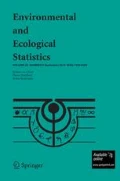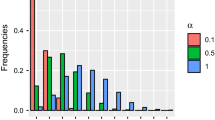Abstract
Ecologists and wildlife biologists increasingly use latent variable models to study patterns of species occurrence when detection is imperfect. These models have recently been generalized to accommodate both a more expansive description of state than simple presence or absence, and Markovian dynamics in the latent state over successive sampling seasons. In this paper, we write these multi-season, multi-state models as hidden Markov models to find both maximum likelihood estimates of model parameters and finite-sample estimators of the trajectory of the latent state over time. These estimators are especially useful for characterizing population trends in species of conservation concern. We also develop parametric bootstrap procedures that allow formal inference about latent trend. We examine model behavior through simulation, and we apply the model to data from the North American Amphibian Monitoring Program.



Similar content being viewed by others
References
Agresti A (2002) Categorical data analysis. Wiley series in probability and statistics. Wiley Interscience, Hoboken, NJ
Altman RM (2007) Mixed hidden Markov models. J Am Stat Assoc 102(477):201–210
Bartolucci F, Farcomeni A, Pennoni F (2012) Latent Markov models for longitudinal data. CRC Press, Boca Raton FL
Baum L, Egon J (1967) An inequality with applications to statistical estimation for probabilistic functions of a markov process and to a model for ecology. Bull Am Meteorol Soc 73:360–363
Baum L, Petrie T, Soules G, Weiss N (1970) A maximization technique occurring in the statistical analysis of probabilistic functions of Markov chains. Ann Math Stat 41:164–171
Cappé O, Moulines E, Rydén T (2005) Inference in hidden Markov models. Springer, Berlin
Conn PB, Cooch EG (2009) Multistate capture-recapture analysis under imperfect state observation: an application to disease models. J Appl Ecol 46:486–492
Dorazio R (2007) On the choice of statistical models for estimating occurrence and extinction from animal surveys. Ecology 88(11):2773–2782
Ephraim Y, Merhav N (2002) Hidden Markov processes. IEEE Trans Inf Theory 48(6):1518–1569
Fiske IJ (2012) Characterizing spatiotemporal trends in amphibian abundance using latent variable models. PhD thesis, North Carolina State University.
Fujiwara M, Caswell H (2002) Estimating population projection matrices from multi-stage mark-recapture data. Ecology 83(12):3257–3265
Giménez O, Viallefont A, Catchpole EA, Choquet R, Morgan BJT (2004) Methods for investigating parameter redundancy. Anim Biodivers Conserv 27(1):561–572
Kendall W, White G, Hines J, Langtimm C, Yoshizaki J (2012) Estimating parameters of hidden markov models based on marked individuals: use of robust design data. Ecology 93:913–920
Link W, Sauer J (1997) New approaches to the analysis of population trends in land birds: comment. Ecology 78(8):2632–2634
MacKenzie D, Nichols J, Seamans M, Gutiérrez R (2009) Modeling species occurrence dynamics with multiple states and imperfect detection. Ecology 90(3):823–835
MacKenzie DI, Nichols JD, Lachman GB, Droege S, Royle JA, Langtimm CA (2002) Estimating site occupancy rates when detection probabilities are less than one. Ecology 83(8):2248–2255
MacKenzie DI, Nichols JD, Hines JE, Knutson MG, Franklin AB (2003) Estimating site occupancy, colonization, and local extinction when a species is detected imperfectly. Ecology 84(8):2200–2207
MacKenzie DI, Nichols JD, Royle JA, Pollock KH, Bailey LL, Hines JE (2006) Occupancy estimation and modeling: inferring patterns and dynamics of species occurrence. Academic Press, USA
McClintock B, Bailey L, Pollock K, Simons T (2010) Experimental investigation of observation error in anuran call surveys. J Wildl Manag 74:1882–1893
Miller D, Weir L, McClintock B, Grant E, Bailey L, Simons T (2012) Experimental investigation of false positive errors in auditory species occurrence surveys. Ecol Appl 22:1665–1674
Nichols JD, Hines JE, MacKenzie DI, Seamans ME, Gutiérrez R (2007) Occupancy estimation and modeling with multiple states and state uncertainty. Ecology 88(6):1395–1400
Pradel R (2005) Multievent: an extension of multistate capture-recapture models to uncertain states. Biometrics 61:442–447
Rabiner LR (1989) A tutorial on hidden Markov models and selected applications in speech recognition. Proc IEEE 77(2):257–286
Royle J (2004) Modeling abundance index data from anuran calling surveys. Conserv Biol 18(5):1378–1385
Royle JA, Kéry M (2007) A bayesian state-space formulation of dynamic occupancy models. Ecology 88(7):1813–1823
Royle JA, Link WA (2005) A general class of multinomial mixture models for anuran calling survey data. Ecology 86(9):2505–2512
Runge JP, Hines JE, Nichols JD (2007) Estimating species-specific survival and movement when species identification is uncertain. Ecology 88(2):282–288
Scott SL, James GM, Sugar CA (2005) Hidden Markov models for longitudinal comparisons. J Am Stat Assoc 100(470):359–370
Weir L, Fiske IJ, Royle JA (2009) Trends in anuran occupancy from northeastern states of the north American Amphibian monitoring program. Herpetol Conserv Biol 4(3):389–402
Weir LA, Royle JA, Nanjappa P, Jung RE (2005) Modeling anuran detection and site occupancy on north American Amphibian monitoring program (NAAMP) routes in Maryland. J Herpetol 39(4):627–639
Welch L (2003) Hidden Markov models and the baum-welch algorithm. IEEE Inf Theory Soc Newslett 53:1–13
Williams D (1991) Probability with martingales. Cambridge University Press, Cambridge
Zucchini W, MacDonald IL (2009) Hidden Markov models for time series: an introduction using R. CRC Press, Boca Raton, FL
Acknowledgments
We thank Linda Weir of PWRC for providing NAAMP data, and we thank John Monahan, Brian Reich and Len Stefanski for constructive comments and discussion. IJF and KG were supported by Grant DEB 08-42101 from the National Science Foundation.
Author information
Authors and Affiliations
Corresponding author
Additional information
Handling Editor: Pierre Dutilleul.
Electronic supplementary material
Below is the link to the electronic supplementary material.
Rights and permissions
About this article
Cite this article
Fiske, I.J., Royle, J.A. & Gross, K. Inference for finite-sample trajectories in dynamic multi-state site-occupancy models using hidden Markov model smoothing. Environ Ecol Stat 21, 313–328 (2014). https://doi.org/10.1007/s10651-013-0256-1
Received:
Revised:
Published:
Issue Date:
DOI: https://doi.org/10.1007/s10651-013-0256-1




